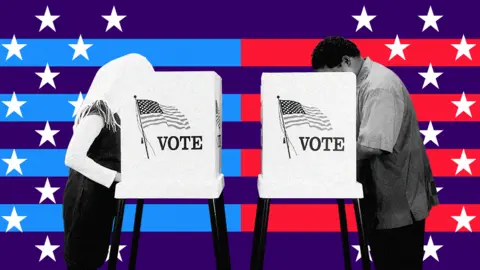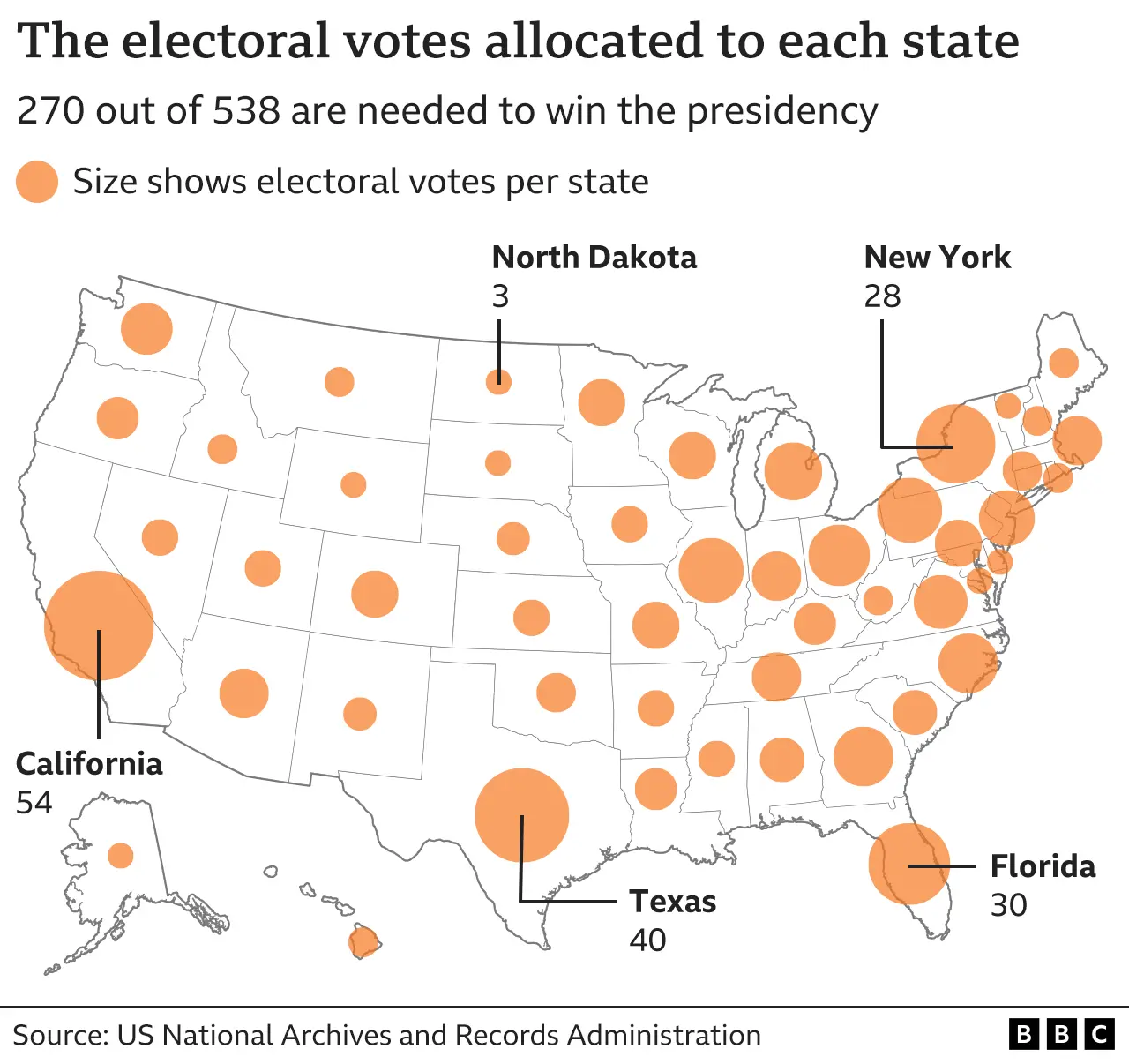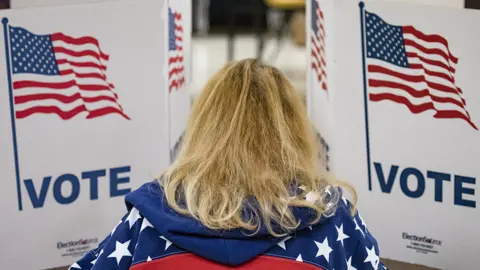What is the US electoral college, and how does it work?
 BBC
BBCAmericans across the nation have cast their votes on the final day of voting in the 2024 US presidential election. But it's possible the candidate with the most votes won't be the winner.
This is because the president is not chosen directly by the voters, but by something called the electoral college.

What is the electoral college?
In the presidential election, most Americans have cast a vote for either Democrat Kamala Harris or Republican Donald Trump.
But those votes don't directly determine who wins. Instead of a national race it's a state-by-state race.
Winning one of the 50 states means that candidate collects all the so-called electoral college votes. There are 538 electoral college votes in total.
A candidate needs to gain a majority of the votes - 270 or more - to win the presidency. Their running mate becomes the vice-president.

How does the electoral college work?
Each state has a number of electoral votes, roughly in line with the size of its population.
California has the most with 54, while a handful of sparsely-populated states like Wyoming, Alaska and North Dakota (and Washington DC) have the minimum of three.
Generally, states award all their electoral college votes to whoever wins the poll of ordinary voters in the state.
For example, if a candidate wins 50.1% of the vote in Texas, they are given all of the state's 40 electoral votes. A candidate who won a state by a landslide would still pick up the same number of electoral votes.

Can you win the most votes across the country but lose the election?
Yes. It's possible for a candidate to become president by winning a number of tight races, despite having fewer votes across the country as a whole.
In 2016, Donald Trump beat Hillary Clinton after polling almost three million fewer votes. In 2000, George W Bush defeated Al Gore even though the Democratic candidate won the popular vote by more than half a million.
Only three other presidents have been elected without winning the popular vote, all of them in the 19th Century.

Why is it called an electoral college?
The word "college" refers to the group of people who are responsible for casting the state votes, who are known as electors.
This system is only used to select the president - all other US elections are decided by a simple popular vote.

What does the electoral college map look like?


Do electors have to vote for the candidate who won in their state?
In some states, electors can theoretically vote for whichever candidate they prefer, regardless of who voters backed.
But in practice, electors almost always vote for the candidate who gets the most votes.
 Getty Images
Getty ImagesIf an elector votes against their state's presidential pick, they are termed "faithless".
In 2016, seven electoral college votes were cast this way, but it did not change the result of the election.
In some states, "faithless" electors can be fined or prosecuted.

What happens if the candidates tie in electoral votes?
If there is no majority winner, the House of Representatives, the lower house of US lawmakers, votes to elect the president.
This has only happened once, in 1824, when four candidates split the electoral college vote, denying any one of them a majority.
Given the current dominance of the Republican and Democratic parties, this is extremely unlikely to happen today.

Why was the electoral college system chosen?
When the US constitution was being drawn up in 1787, a national popular vote to elect a president was practically impossible because of the size of the country and a lack of reliable communication methods.
The framers of the constitution therefore created the electoral college system.
It was popular with southern states where slaves made up a large portion of the population.
They couldn't vote but were counted as part of the population, giving southern states an outsized influence.

What are the pros and cons of the electoral college system?
Advantages:
- smaller states remain important to candidates
- candidates don't need to travel the whole country but can focus on key states
- recounts are easier because officials can isolate the issue in one state
Disadvantages:
- the popular vote winner can lose the election
- some voters feel their individual vote does not matter
- too much power resides in the so-called "swing states"

What are swing states?
Most states consistently vote for the same party in every election.
This is why presidential candidates target specific "swing states" where the vote could go either way rather than trying to win over voters across the whole country.
In 2024, the top battleground states are Arizona, Georgia, Michigan, Nevada, Pennsylvania and Wisconsin.

What are fake electors?
In 2020, US voters became familiar with the concept of "fake electors" after pro-Trump Republicans in seven US states created their own electors in a bid to overturn the election results.
In some cases, they created and signed official-looking documents or arrived at state capitals on 14 December - when electors across the country met to officially cast their votes.
Some of those involved have faced prosecution and investigations are still ongoing.

- SIMPLE GUIDE: All you need to know about the US election
- POLL TRACKER: Who is ahead - Harris or Trump?
- FACT CHECK: Was US economy stronger under Biden or Trump?
- POLICY: What are Harris and Trump's policies?
- ANALYSIS: Only one candidate is talking about China

North America correspondent Anthony Zurcher makes sense of the race for the White House in his weekly US Election Unspun newsletter.
Readers in the UK can sign up here. Those outside the UK can sign up here.
